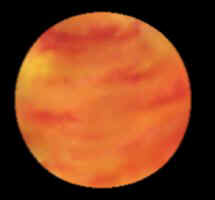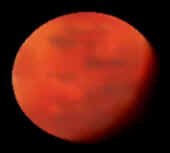Home |
Star Fleet Library |
BuPers |
SF Engineering |
SF Intelligence |
SF JAG |
SF Marine Corps |
SF Medical |
SF Records |
SF Sciences
UFP Dept. of Colonial Affairs |
UFP Educational, Scientific and Cultural Org.
Planet Classes and their Particular Properties
A-Class Planet
| Class A Planets are Gas Super Giants. 300 to 1000 times the size of Earth, and located in their Suns Cold Zone they are hot and have a high gravity. The high gravity means a dense, mainly Hydrogen, atmosphere is maintained.
|

|
B-Class Planet
| This type of large planet is a Gas Giant. Class B Planets are located in the Suns Cold Zone and are about 10 to 100 times the size of Earth. Due to their high gravity, much of the Hyrdrogen hasn't excaped the planet, and consequently a thick Hydrogen atmosphere surrounds the planet.
|

|
C-Class Planet
| Class C Planets are the same size as Earth. They are located in the Suns Habitable Zone, but have little water in vapour form, or no water at all. Class C Planets have high quantities of Carbon Dioxide gas as well. They were once Class F planets.
|

|
D-Class Planet
| Class E Planets are the same size as Earth. They are recently formed, having been Class D, with a very thin crust. They will cool to Class F, and they still have Hydrogen left in the atmosphere.
|

|
E-Class Planet
| Class E Planets are the same size as Earth. They are recently formed, having been Class D, with a very thin crust. They will cool to Class F, and they still have Hydrogen left in the atmosphere.
|

|
F-Class Planet
| Class F Planets are the same size as Earth, and are older than Class E, but slightly younger than Earth (Class M). Located in the Suns Habitable Zone, these planets can cool to Class C, M or N and still have small amounts of toxic gasses.
|

|
G-Class Planet
| Located in the Suns Hot Zone, Class G Planets have a very hot surface and strong gravity. The hot surface means the atmosphere is composed of metal vapours, and can not escape due to the strong gravity.
|

|
H-Class Planet
| Smaller than earth (about 1 to 1/10 the size of Earth), Class H Planets are newly formed, with Hydrogen atmospheres . They are located in the Suns Cold Zone, and will cool to Class L Planets.
|

|
I-Class Planet
| Tiny planets, 1/100 the size of Earth or less, Class I Planets are generally lifeless. They have no atmosphere due to the low gravity, and consequently are very cratered.
|

|
J-Class Planet
| These small (1/10 of Earth) size planets are located in the suns Hot Zone. Because of their low gravity, they have no atmosphere but they have very hot surfaces. They have few chemically active gasses.
|

|
K-Class Planet
| Although small (1/10 Earth), Class K Planets, located in the Suns Habitable Zone, do have water despite their weak atmosphere.
|

|
L-Class Planet
| Cooled from Class H, Class L Planets are slightly smaller than Earth at 1 to 1/10 the size of Earth and are located in the Suns Cold Zone. Because of this, they have cooled and have frozen atmospheres.
|

|
M-Class Planet (Terra)
| M Class Planets, having cooled from Class F, are the size same as Earth with a stable crust. They have various gases in the atmosphere (Nitrogen, Oxygen, Carbon Dioxide and others), as well large quantities of water. If the water level increases they become Class N. Class M Planets are located in the Suns Habitable Zone.
|

|
N-Class Planet
| Class N Planets are very similar to N except more than 90% of the surface is covered in water. They have a range of gases in the atmosphere (Nitrogen, Oxygen, Carbon Dioxide and others), having cooled from being Class F. Class N Planets are located in the Stars Habitable Zone.
|

|
S-Class Planet
| Gas Ultra Giants, approximately 10,000 times the size of Earth and located in the Suns Cold Zone are extreamly hot and radiate light. They have thick atmospheres due to huge gravity, and if they become slightly larger may initiate Fusion inside and become a star.
|

|
For additional information see: Star Classes, Star Structure
T-Class Planet
| Class T Planets are Gas Super Giants, about 3,000 times the size of Earth. They are located in the Suns Cold Zone, and have a thick atmosphere. Water is present on Class T Planets.
|

|
Disclaimer
This material was developed for use in ASR and is not intended to apply anywhere outside ASR. You are welcome to bookmark our pages and view them repeatedly without being a player in ASR. No other use of the material contained within the ASR Manual- including copying or altering any of the pages within for one's own use- is permitted. For further information about joining ASR, please click here.












